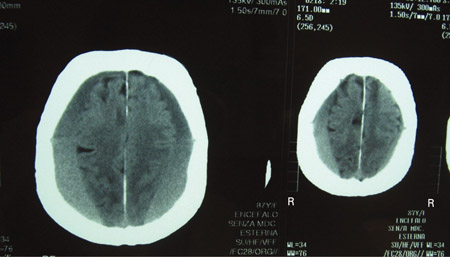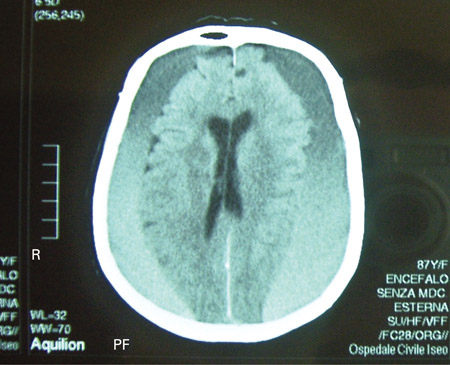Tests
1st tests to order
noncontrast CT scan
Test
The investigation of choice for all patients who have suspected acute or chronic subdural hematoma (SDH) based on the history and the physical and neurologic exams.[48][49][56] Subdural fluid collections are usually crescentic in shape and unlike epidural hematomas which are lenticular, and typically do not cross suture lines.[57] Acute hematomas are hyperdense, isodense, or mixed-density.[33][58][59] Rarely, acute SDHs may be almost isodense relative to the brain parenchyma, for example, in the hyperacute phase in a profoundly anemic patient or in a patient with an arachnoid tear and a mixture of hemorrhage and cerebrospinal fluid. There may be effacement of the underlying sulci or midline shift, effacement of cisterns or other signs of herniation, or skull fracture or other intracranial hematomas. Cerebral swelling may be manifested as the loss of gray-white matter distinction or gyral integrity. SDHs that have a hypodense "swirl" inside them signify potential hyperacute hematoma with active bleeding.[60][61]
[Figure caption and citation for the preceding image starts]: CT scans of the brain of an 80-year-old man with a gait disorder and a progressive cognitive impairment dating back about 6 months, showing a bilateral chronic subdural hematoma up to the convexityAdapted from BMJ Case Rep. 2009;2009:bcr06.2008.0130 [Citation ends]. [Figure caption and citation for the preceding image starts]: CT scan of the brain of an 80-year-old man with a gait disorder and a progressive cognitive impairment dating back about 6 months, showing a bilateral chronic subdural hematoma up to the convexityAdapted from BMJ Case Rep. 2009;2009:bcr06.2008.0130 [Citation ends].
[Figure caption and citation for the preceding image starts]: CT scan of the brain of an 80-year-old man with a gait disorder and a progressive cognitive impairment dating back about 6 months, showing a bilateral chronic subdural hematoma up to the convexityAdapted from BMJ Case Rep. 2009;2009:bcr06.2008.0130 [Citation ends].
Result
subdural fluid collection
Tests to consider
MRI scan
Test
Useful when there are persistent neurologic deficits that remain unexplained after CT, especially in the subacute or chronic phase or in the absence of trauma history.[48] May identify differential diagnoses (e.g., lymphoma, metastasis, sarcoma, infection).
Similar results to CT scan. Intensities of fluid collection differ according to the age of the hematoma. Indicated as a follow-up study when there are persistent neurologic deficits that remain unexplained after a head CT.[48] MRI has superior sensitivity relative to CT for most acute intracranial findings, including small brain contusions, small extra-axial hematomas and diffuse axonal injury.[49][63][64]
Result
subdural fluid collection
Use of this content is subject to our disclaimer